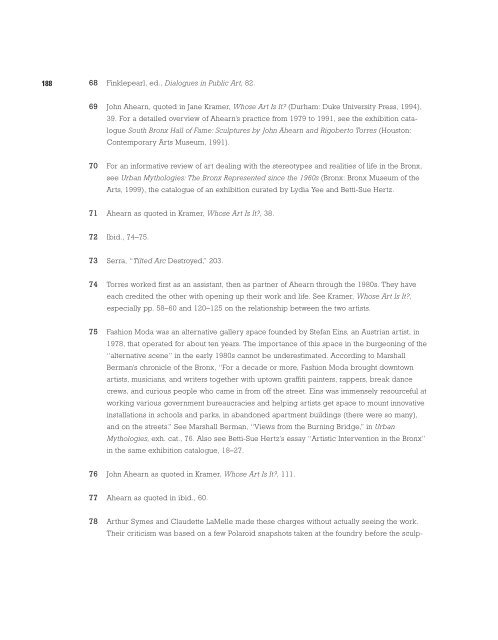ONE PLACE AFTER ANOTHER - Monoskop
ONE PLACE AFTER ANOTHER - Monoskop
ONE PLACE AFTER ANOTHER - Monoskop
Create successful ePaper yourself
Turn your PDF publications into a flip-book with our unique Google optimized e-Paper software.
188<br />
68 Finklepearl, ed., Dialogues in Public Art, 82.<br />
69 John Ahearn, quoted in Jane Kramer, Whose Art Is It? (Durham: Duke University Press, 1994),<br />
39. For a detailed overview of Ahearn’s practice from 1979 to 1991, see the exhibition cata-<br />
logue South Bronx Hall of Fame: Sculptures by John Ahearn and Rigoberto Torres (Houston:<br />
Contemporary Arts Museum, 1991).<br />
70 For an informative review of art dealing with the stereotypes and realities of life in the Bronx,<br />
see Urban Mythologies: The Bronx Represented since the 1960s (Bronx: Bronx Museum of the<br />
Arts, 1999), the catalogue of an exhibition curated by Lydia Yee and Betti-Sue Hertz.<br />
71 Ahearn as quoted in Kramer, Whose Art Is It?, 38.<br />
72 Ibid., 74–75.<br />
73 Serra, “Tilted Arc Destroyed,” 203.<br />
74 Torres worked first as an assistant, then as partner of Ahearn through the 1980s. They have<br />
each credited the other with opening up their work and life. See Kramer, Whose Art Is It?,<br />
especially pp. 58–60 and 120–125 on the relationship between the two artists.<br />
75 Fashion Moda was an alternative gallery space founded by Stefan Eins, an Austrian artist, in<br />
1978, that operated for about ten years. The importance of this space in the burgeoning of the<br />
“alternative scene” in the early 1980s cannot be underestimated. According to Marshall<br />
Berman’s chronicle of the Bronx, “For a decade or more, Fashion Moda brought downtown<br />
artists, musicians, and writers together with uptown graffiti painters, rappers, break dance<br />
crews, and curious people who came in from off the street. Eins was immensely resourceful at<br />
working various government bureaucracies and helping artists get space to mount innovative<br />
installations in schools and parks, in abandoned apartment buildings (there were so many),<br />
and on the streets.” See Marshall Berman, “Views from the Burning Bridge,” in Urban<br />
Mythologies, exh. cat., 76. Also see Betti-Sue Hertz’s essay “Artistic Intervention in the Bronx”<br />
in the same exhibition catalogue, 18–27.<br />
76 John Ahearn as quoted in Kramer, Whose Art Is It?, 111.<br />
77 Ahearn as quoted in ibid., 60.<br />
78 Arthur Symes and Claudette LaMelle made these charges without actually seeing the work.<br />
Their criticism was based on a few Polaroid snapshots taken at the foundry before the sculp-

















